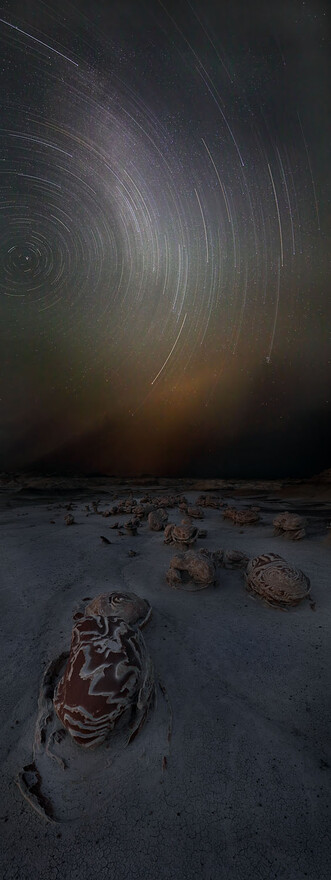- Home
- Inspiration
- Terra Map
- Galleries
-
Photographers
- All photographers
-
Interviews
- All
- 21 exceptional interviews
- Ales Komovec
- Alessandro Carboni
- Alexandre Deschaumes
- Alex Noriega
- Andrew George
- Anne Mäenurm
- An interview with Antonio Fernandez
- Beata Moore by... Terra Quantum
- Caterina Mrenes
- Charlotte Gibb
- Chris Davis
- Claes Thorberntsson
- Cole Thompson
- Daniel Laan
- Daniel Mirlea
- David Frutos Egea
- Dino Lupani
- Fred Bucheton
- Hans Strand
- Heike Odermatt
- Heiko Gerlicher
- Hengki Koentjoro
- Huibo Hou
- Isabella Tabacchi
- Isabelle Bacher
- Marian Kuric
- Mieke Boynton
- Patricia Davidson
- Peter Svoboda
- Raico Rosenberg
- Samuel Feron
- Sue Trower
- Szabo Zsolt Andras
- Theo Bosboom
- Tom Hegen
- Yucel Basoglu
- Jury



The Cracked Eggs of the Bisti Wilderness, also known as De-Na-Zin, in northwestern New Mexico is among the most otherworldly landscapes on our planet, when viewed under the starry sky of the Milky Way. The Navajos called this region on the southeastern edge of the Colorado Plateau quite symbolically 'Great Area with Hills'. The additional name De-Na-Zin refers to cranes in the Navajo language and very aptly describes the appearance of many of the rock formations in the area. With the goal of photographing this fairly remote and odd rock formation of the Cracked Eggs under the stars of the Milky Way, I headed out early in the morning for the long hike to get there. This provided me with sufficient time to explore the area thoroughly and to locate the best photographic composition. In the midst of these badlands, so rich in shapes and colors, the almost two meters long (6.5 feet) formation of the Cracked Eggs particularly stimulate the fantasy. One could easily recognize crawling prehistoric creatures in them. In fact, however, what we are looking at is 73 to 70 million year old mud from a shallow ocean. This ocean covered large parts of the central North American continent in the Cretaceous period, during the age of the dinosaurs. It connected the Gulf of Mexico with the Arctic Ocean. With this enchanting scenery of the Cracked Eggs in the foreground, I set up my star-tracking device and started photographing the 180° arc of the Milky Way above this landscape. The impressively bright starry sky far from any city lights paired with the absolute silence in this surreal landscape made a deep impression. In such moments, I humbly merge with nature, becoming one with the landscape and the starry sky. After two and a half hours of photographic work on the Milky Way panorama, my star tracker was extended to its maximum and therefore automatically retracted to its zero position. At the time the star tracker retracted, the camera shutter had been open for four minutes and had photographed pointy stars. Now another 30 seconds were added to this exposure while the device was rotating back, which is equivalent to two and a half hours of star trails. This resulted in a fascinating combination of tracked stars and star trails, with Polaris remaining pointy at the center of the rotation. Only the bright stars in the night sky became trails since the camera was able to gather their light fast enough. Particularly striking is the Pleiades starcluster. The remote lightning of the thunderstorms lit up the horizon in diffuse yellow while the clouds stood out in black against the starry sky, completing this image to a unique composition. It seemed to me as if primordial creatures were chasing the stardust falling from the sky. During the long exposures of my astrophotography, I hardly move at all, to avoid any vibration being transmitted to the tripod. After finishing my exposures, I switched on my headlamp and explored the surroundings. A track immediately caught my eye, which crossed my own track at right angles. The characteristic imprints in the sand revealed the presence of a cougar. When had this track been made? I examined the track more closely and found the imprint of a paw in my own footprint. This cougar was there while I was taking the pictures in the dark of the night. He had been watching me while I had no idea of his presence. This intense and humble feeling of being a visitor in the home of a cougar flooded through me. I felt my silent question, am I welcome here? I did not get to see this majestic mountain lion, but his paw imprint in my own footprint not far from my tripod signaled his answer: I know you are there, I recognize your humility, and I tolerate you in my territory. Had it been otherwise, the cougar would have shown himself and signaled to me that I would not be welcome. August 2018 Canon 5DSR, Rokinon 14 mm, f/2.8, composite of static and dynamic exposures of 4:30 minutes each, 15.312x5.753 pixels, 88.1 megapixels, ISO 1600, Manfrotto 055CB tripod with Manfrotto 410 geared head, AstroTrac TT320 digital star tracking device. [+]
[-]